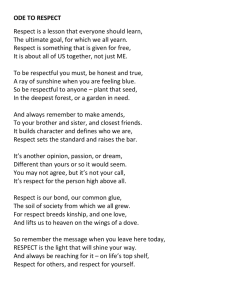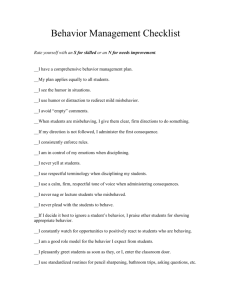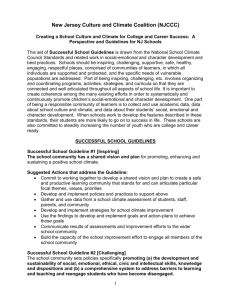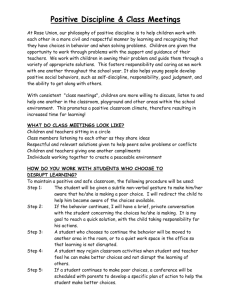Practice Resources - Respectful Language Guideline
advertisement
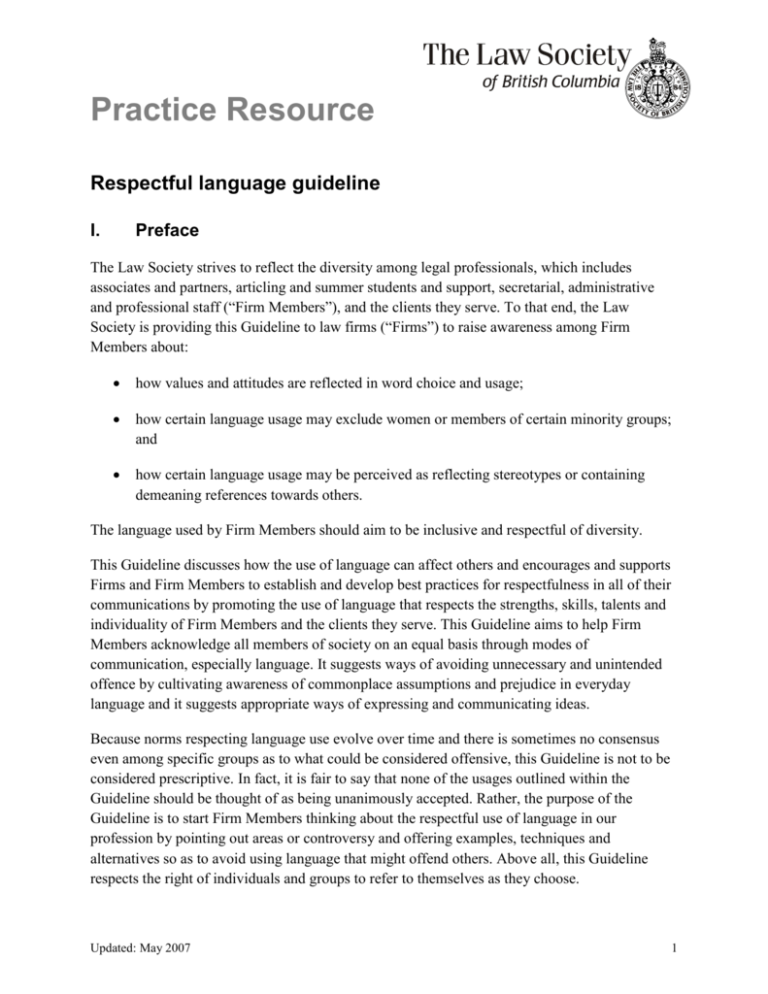
Practice Resource Respectful language guideline I. Preface The Law Society strives to reflect the diversity among legal professionals, which includes associates and partners, articling and summer students and support, secretarial, administrative and professional staff (“Firm Members”), and the clients they serve. To that end, the Law Society is providing this Guideline to law firms (“Firms”) to raise awareness among Firm Members about: how values and attitudes are reflected in word choice and usage; how certain language usage may exclude women or members of certain minority groups; and how certain language usage may be perceived as reflecting stereotypes or containing demeaning references towards others. The language used by Firm Members should aim to be inclusive and respectful of diversity. This Guideline discusses how the use of language can affect others and encourages and supports Firms and Firm Members to establish and develop best practices for respectfulness in all of their communications by promoting the use of language that respects the strengths, skills, talents and individuality of Firm Members and the clients they serve. This Guideline aims to help Firm Members acknowledge all members of society on an equal basis through modes of communication, especially language. It suggests ways of avoiding unnecessary and unintended offence by cultivating awareness of commonplace assumptions and prejudice in everyday language and it suggests appropriate ways of expressing and communicating ideas. Because norms respecting language use evolve over time and there is sometimes no consensus even among specific groups as to what could be considered offensive, this Guideline is not to be considered prescriptive. In fact, it is fair to say that none of the usages outlined within the Guideline should be thought of as being unanimously accepted. Rather, the purpose of the Guideline is to start Firm Members thinking about the respectful use of language in our profession by pointing out areas or controversy and offering examples, techniques and alternatives so as to avoid using language that might offend others. Above all, this Guideline respects the right of individuals and groups to refer to themselves as they choose. Updated: May 2007 1 Law Society of British Columbia Practice Resource: Respectful language guideline This Guideline deals with the general principles of Respectful Language use including GenderNeutral Language use. The Guideline also identifies specific issues regarding terminology involving the following groups: Women; People of Diverse Races, Ethnicities, or Countries of Origin; People of Aboriginal Descent; People with Disabilities; People who are Lesbian, Gay, Bisexual and Transgender; and Adoptive Families. II. General principles 1. Avoid mentioning personal characteristics unless relevant As a general rule, personal characteristics, such as race, sexuality and disability, should only be referred to when they are relevant to the communication. Otherwise avoid mentioning them. 2. Inclusive Language and Person First Construction If a subject’s personal characteristics are relevant to the communication, it is useful to follow the principles of Inclusive Language and Person First Construction in making the communication. Inclusive Language is language that does not stereotype or demean people based on personal characteristics including gender, race, ethnicity, disability, religion, sexual orientation, etc. Use inclusive language to emphasize or focus the reader’s attention on similarities, equality and respect. Conversely, avoid using language that detracts from the sense of value of the whole person and terms that exclude, marginalize, diminish or lower the status of any individual or group (e.g., “us and them” constructions). In addition, avoid stereotypes and words that are derived from negative assumptions e.g., using the expression “going Dutch” for “splitting the bill”. Person-First Construction places people ahead of personal characteristics, e.g. “a person with a disability” instead of “a disabled person”. Person-first communication emphasizes or focuses 2 Law Society of British Columbia Practice Resource: Respectful language guideline attention on a subject’s personhood, rather than on cultural, ethnic, linguistic, national or the existence of a disability, illness or condition. 3. Terms preferred by the group or individual The Law Society recognizes the right of individuals and groups to refer to themselves as they choose. In that regard, the Law Society is guided by the principle that “respectful language” must respect the preferences of the people being referred to or addressed. Therefore, individuals and groups should be described using the term(s) preferred by that individual or group. Accordingly, it is important to guard against making assumptions as to how individuals or groups wish to be addressed. If in doubt, it is often best to simply ask. 4. Gender-Neutral language Using language that is truly gender-neutral is more than simply avoiding certain terminology. The English language contains many gender-specific usages that may exclude or limit women. In particular, be mindful of the following: False generics – Generics are nouns and pronouns that are intended to be used for both women and men. However, linguistically, some generics are male-specific. For example, the word “man” was generically used to mean “human being” or “person” but, over the years, it has come to mean only “male persons.” Such use of generics should be avoided as they are not gender neutral. Parallel treatment – Gender neutral language strives for overall gender balance in your written and spoken communications by treating men and women in a parallel way (e.g. “husband and wife” or “man and woman” instead of “man and wife”). Stereotypes – Avoid using biased or stereotyped terms that may be demeaning or offensive. Also avoid using gendered adjectives where gender is irrelevant (e.g., “lady doctor”, “woman lawyer” and “male nurse”). For more detailed suggestions for gender-neutral language usage, please see Appendix A. III. Specific contexts Determining appropriate language and terminology use with regard to traditionally marginalized groups can sometimes be complicated or even seem contradictory. Because many of these groups are only recently going through the process of self-determination, consensus has yet to develop as to what language and epithets are considered correct or inoffensive. Further complicating things are the conscious attempts by members of particular groups to reclaim, for political reasons, terminology that may have once been considered offensive. In other cases, the sheer size 3 Law Society of British Columbia Practice Resource: Respectful language guideline and diversity of a group defeats anything more detailed than a broad statement of principles (see “Race and Ethnicity”). In short, it is not always feasible to set out a universally agreed-upon list of terms and phrases that one should avoid when communicating to these groups. What this section will do is offer some principles to observe when communicating to or about specific groups. It also attempts to identify potential issues or pitfalls, understanding that these may change over time. Finally, recall the general principles set out in Section II, especially the right of individuals and groups to refer to themselves as they choose. 1. Women See previous discussion on Gender-Neutral Language use and Appendix A. 2. People of diverse races, ethnicities, or countries of origin General principles As the specific issues of communications involving race and ethnicity are as diverse as race and ethnicity themselves, this Guideline will only confine itself to the following general principles: As a general rule, avoid referring to a person’s race, ethnicity or country of origin unless it is relevant to the communication. Avoid using stereotypes and archaic expressions that may be demeaning or offensive, e.g., using “going Dutch” to mean “splitting the bill.” Do not assume that all people belonging to particular communities act or think the same way. Accordingly, avoid making sweeping generalizations involving entire communities, e.g., saying that a particular ethnic group is inclined to be socially conservative. Potential issues “Visible minorities” is a term used in federal legislation to describe persons who are not of the majority race in a given population. Visible minorities are defined under the Employment Equity Act as “persons, other than Aboriginals, who are non-Caucasian in race or non-white in colour.” The term “visible minorities” is also used as a demographic category by Statistics Canada. In March 2007, the United Nations Committee on the Elimination of Racism denounced the term “visible minorities” and Canada’s use of it as racist. A spokesperson for the Committee explained, “the use of the term seemed to somehow indicate that ‘whiteness’ was the standard, all others differing from that being visible.” However, the Committee did not suggest an alternative term. 4 Law Society of British Columbia Practice Resource: Respectful language guideline Also note that the term “race” is controversial among those who assert that there is only one race, the human race, and that traditional notions of racial differences are artificial and arbitrary constructs. Proponents of this view prefer the use of the term “racialized groups” to describe people that would be traditionally referred to as visible minorities. This term reinforces the idea that “race,” or more properly “racialization,” is something imposed on a person by outside perception. 3. People of Aboriginal descent General principles “Aboriginal” is generally used to refer to all three constitutionalized Aboriginal groups: Status Indian, Métis and Inuit. Aboriginal is a generic term. It is usually preferable to refer to a particular First Nation by its chosen name if you are targeting it for identification, such as: Nisga’a, Haida, Tlingit etc. With such usage, many First Nations dispense with the use of the term First, as in Kwakiutl Nation instead of Kwakiutl First Nation. “Indigenous” is the term preferred for international discussions of other aboriginal peoples from places outside of Canada. Avoid using the term “Indian” to refer to Aboriginal people unless you are specifically referring to a person who is a Status Indian registered under the Indian Act and that fact is relevant to the communication. Potential issues Often the terms “Aboriginal,” “First Nations,” “Native,” “Indigenous” and even “Indian” are used interchangeably, sometimes by members of the Aboriginal community. However, it should be recognized that these terms carry different social and political meanings to different people. Therefore, when dealing with specific people or groups from the Aboriginal community, it is always best to find out what term they prefer. 4. People with disabilities General principles Use person-first constructions that put the person ahead of the disability, e.g., instead of “a blind woman” or “a diabetic” use “a woman who is blind” or “a person with diabetes.” Just as it is not always necessary to convey the color of a person’s hair or skin, do not mention that a person has a disability unless it is relevant to the communication. 5 Law Society of British Columbia Practice Resource: Respectful language guideline Avoid using language that casts disabilities as negative. For example, avoid using phrases such as suffers from, afflicted with or victim of, as such expressions cast disabilities as negative attributes. By the same token, avoid using the terms handicapped, challenged and crippled. Most disabilities are not diseases. Do not refer to a person with a disability as a patient unless that person is in a hospital or care facility. In the context of occupational or physical therapy, the term client is preferable. Potential issues Although the majority of disability advocacy groups and members of the disability community generally accept the term “disability,” there are some who believe that even the term “disability” itself is pejorative. Such people may often prefer to use terms such as “differently abled” or may characterize a disability as simply a difference rather than any sort of impediment, for example, members of Deaf Culture. For more detailed suggestions regarding the correct terms for specific disabilities, please see Appendix B. 5. People who are lesbian, gay, bisexual or transgender (“LGBT”) General principles When referring to people who are lesbians, gay, bisexual or transgender, the abbreviation LGBT may be used after the first use of the full phrase. In referring to LGBT, the word homosexual is often considered insulting. The term gay is most often used to refer to gay men although many women also identify as gay. However, most women prefer the term lesbian. Bisexual describes an individual who is sexually attracted to members of both genders. It does not presume non-monogamy. Transgender is an umbrella term that can include preoperative, postoperative or nonoperative transsexuals, female and male crossdressers, drag queens or kings, female or male impersonators and intersex individuals. If an individual prefers to be called transsexual, drag queen or king, etc., use that term. Avoid using the term transvestite. The expression same sex is an adjective that is used in preference to homosexual to refer to something that lesbians and gay men do or have as a result of being in a relationship, for example: same sex marriage or same sex relationship. 6 Law Society of British Columbia Practice Resource: Respectful language guideline Sexual orientation is the legal term used within Provincial Human Rights Codes and within the Charter context. Courts and tribunals have interpreted sexual orientation to be an all-inclusive expression for the various sexual identities that exist. The term sexual orientation is inclusive of lesbian, gay, bisexual and transgender people. Queer is a term used by people inside the communities and academics in certain contexts as a way of re-appropriating the term, which was originally pejorative. Avoid using this term except in these specific contexts. With respect to families, it is preferable to refer simply to parents and families unless it is relevant to refer to the fact that the parents are of the same gender. The majority of same-sex parents prefer to be referred to as a family with two-moms or a family with two-dads. In referring to two men or two women who have married, they usually refer to the other as their spouse. The term spouse is neutral but designates their status as a married couple. The term partner is also neutral but does not designate their marital status and is more commonly used by people living in a common-law relationship. Possible issues Language use around LGBT issues is still evolving so none of the usages outlined above should be thought of as being unanimously accepted. In particular, the rejection of previously acceptable terms (e.g., “homosexual”) and the reclaiming of previously pejorative terms (e.g., “queer”) are not universal. As always, this Guideline respects the right of individuals and groups to refer to themselves as they choose. 6. Adoptive families Adoption is a part of many families. The following are some suggested guidelines for respectful language about adoption and families. When referring to a person having been adopted, use the expression Jane was adopted instead of Jane is adopted. The latter makes the adoption process sound like a condition rather than a process. Similarly, avoid using expressions such as Doug’s adopted daughter unless the adoption is relevant to the discussion. When referring to a person’s birth parents use expressions such as birth-mother or birthfather instead of real mother or real father. 7 Law Society of British Columbia IV. Other forms of communication 1. Visual communications Practice Resource: Respectful language guideline The principles that underlie respectful language guidelines for written and spoken material apply to visual communications as well. Minority groups should be portrayed as equals. Members of minority groups should be depicted in positions of authority and as having achieved success in a wide variety of endeavours. It is important that the total presentation depicts a diverse range of people: Members of minority groups as equal and active participants in all aspects of life —at home, in the workplace, in school, in public life and in the community; People of various ages, ethnic origins and of differing physical attributes; People in non-traditional and non-stereotyped roles —for example, women in technical or financial positions and men as nurses or secretaries; Members of minority groups in positions at all levels of authority and of comparable status; and Members of minority groups as being successful in a variety of endeavours –for example, career, home, education, community, public life. 2. Audio and oral communications Audio and oral communications — whether on their own or as part of a visual presentation — should be guided by the same principles of fairness as written materials. In addition, when preparing speeches, seminars and audio-visual voice-overs, remember to: use members of minority groups as interviewers, interviewees and speakers at events; and use female voices as often as male voices in voice-overs and ensure that dialogue and style of expression convey equal status and authority when alternating between male and female voices. 8 Law Society of British Columbia Practice Resource: Respectful language guideline APPENDIX A – Gender-Neutral language I. False generics Generics are nouns and pronouns intended to be used for both women and men. Linguistically, however, some generics are also male-specific, which can create ambiguity. Traditionally, the word man was generically used to mean human being or person but, over the years, it has come to mean only male persons. The generic use of man causes ambiguity that can be avoided by using gender-neutral generics. Similarly, the use of he, his and him for antecedents of an unspecified gender is not gender-neutral. Below are some suggested alternative approaches: Use the plural Recasting a sentence in the plural is often the best choice. Instead of: Each office manager should ensure that he attends the meeting. Preferred: Office managers should ensure that they attend the meeting. If you do convert to the plural, avoid making the sentence ambiguous. The following is an example: Singular: The vice-president should ensure that the regional manager understands the policy before he attends the meeting. Plural: Vice-presidents should ensure that regional managers understand the policy before they attend the meeting. The ambiguity can be resolved by reordering the sentence as follows: Before vice-presidents attend the meeting, they should ensure that regional managers understand the policy. Eliminate personal pronouns Another technique is to eliminate gender-specific personal pronouns altogether. Instead of: Each applicant must submit his resume. Preferred: Each applicant must submit a resume. 9 Law Society of British Columbia Practice Resource: Respectful language guideline Use he or she The expression he or she (or she or he) is an acceptable substitute for the generic he. Some people use it specifically to draw attention to the fact they are including both women and men, as in the following example: Each applicant must submit her or his resume. Used sparingly, the expressions he or she and his or her can be very helpful solutions. Use you In some cases you can avoid using the generic he by addressing the reader directly. Instead of: Each driver must be sure to renew his automobile insurance annually. Preferred: Be sure to renew your automobile insurance annually. Use one You can sometimes use one in place of a third-person pronoun. Bear in mind this usage will change the tone of your writing by making it more formal and distanced. Instead of: A consumer should compare prices before he buys groceries. Preferred: As a consumer, one should compare prices before buying groceries. Use a gender-neutral synonym In order to avoid using the generic he, use gender-neutral synonyms instead of repeating antecedent nouns. Instead of: Every charitable organization has an executive director. He is responsible for the administration of the agency. Preferred: Every charitable organization has an executive director. This official is responsible for the administration of the agency. Use they as a singular pronoun The singular use of they is most acceptable when used to refer to gender-indefinite antecedents like any, anyone, each, every, everybody, everyone, nobody, no one, someone and somebody. Here are some examples: Instead of: Nobody got his cheque on Friday. 10 Law Society of British Columbia Practice Resource: Respectful language guideline Preferred: Nobody got their cheque on Friday. Instead of: Everyone loves his dog. Preferred: Everyone loves their dog. Rewrite the sentence If nothing else works, you might have to rewrite the sentence by combining a number of techniques, as in the following example: Instead of: When an editor revises a document, he usually marks his changes in pen or pencil. Preferred: When revising a document, an editor usually marks changes in pen or pencil The sentence was restructured and the personal pronoun was deleted. Another alternative would be the addition of a relative clause, as in the following example: An editor who is revising a document usually marks changes in pen or pencil. Things to avoid when eliminating he 1. Do not use s/he or (s)he or any of their variants. Although these forms provide a quick solution, they are awkward and interruptive. 2. Do not repeat nouns. Instead of: The treasurer must draft the budget. The treasurer is also responsible for the agency’s financial statements. Preferred: The treasurer, who is also responsible for the agency’s financial statements, must draft the budget. If necessary, restructure or combine sentences. 3. Do not use the passive voice to avoid the generic he unless absolutely necessary. The passive voice is less direct than the active voice as it deletes the “doer” of the action. This can sometimes result in ambiguity. Use the active voice, for example: Before filing an appeal, each candidate should understand the correct procedure. 4. Do not alternate gender-neutral and gender-specific terms for the same subject. 11 Law Society of British Columbia Practice Resource: Respectful language guideline For example, do not switch from police-officer to policewoman to policeman unless there is a specific reason to do so. 5. Do not alternate between the generic she and the generic he. Avoid using the generic she in one paragraph and the generic he in the next, and so on. 6. Babies and infants When writing or speaking of babies and infants, you can alternate your use of the generic she in one chapter or section and the generic he in the next. In short passages, it is best to find alternatives to personal pronouns. 7. Do not use disclaimers The practice of using a disclaimer to advise readers that the use of the male pronoun in the texts is intended to include women is not preferred. There are other more effective alternatives, as described above, to the use of the generic he. II. Parallel treatment Strive for overall gender balance in your written and spoken communications. Generally, your audience will be comprised of both men and women, so you should address yourself to them equally. Use inclusive, rather than exclusive, language and use gender-marked terms appropriately. Use an equal number of male and female hypothetical names or case studies. Parallel language Use parallel language when referring to the sexes: Instead of: Use: men and ladies men and women/women and men; gentlemen and ladies/ ladies and gentlemen man and wife husband and wife/wife and husband Miss Sorensen and Robert Tanaka Mary Sorensen and Robert Tanaka Mr. Tanaka and Mary Tanaka and Sorensen; Robert and Mary Generalizations Avoid generalizations that exclude women or assign gender to gender-neutral subjects. For example: 12 Law Society of British Columbia Practice Resource: Respectful language guideline Instead of: Conference delegates and their wives are invited to attend the breakfast meeting. Preferred: Conference delegates and their spouses are invited to attend the breakfast meeting. Word order Be conscious of word order. Alternate customary phrases, such as men and women and boys and girls so that men do not always go first. For example: use women and men and girls and boys. Ladies and gentlemen. This pairing continues to be commonly used in public speaking. However, many speakers now prefer to use other terms, such as, colleagues, delegates and members of the association to begin their speeches. Asymmetrical usage Be consistent in how you use forms of address, both in speaking and in writing. Instead of: Dr. Jim Evans and his assistant, Mary. Preferred: Dr. Jim Evans and his assistant, Mary Jones. The use of Ms. The female equivalent of Mr. is Ms. (the plural form of which is Mses.). However, if a woman indicates that she prefers to be called Mrs. or Miss, follow her preference. Salutations in letters If a person has a professional or academic title, such as Dr. or Professor, use it. If writing to a company or firm and you wish to address both the company or firm and the individual use, Dear Sirs and Mesdames, Attention: Jane Brown. 1. To one person (gender known) Consider omitting courtesy titles. Instead of: Dear Mrs. Wilson and Dear Mr. Goldberg. Preferred: Dear Joan Wilson and Dear Howard Goldberg. 2. To one person (identity or gender unknown) 13 Law Society of British Columbia Practice Resource: Respectful language guideline Instead of: Dear Sir. Preferred: Dear Sir or Madam or Dear Madam or Sir. If you know a person’s name and/or initials but not their gender, omit the courtesy title. For example: Dear C.L. Carter or Dear Chris Carter. 3. To more than one person (gender known) Use Dear Mses. Rodriguez and Bernstein, Dear Maria Rodriguez and Muriel Bernstein, Dear Messrs. Andersen and Leblanc or Dear Edward Andersen and Norman Leblanc. When circulating a document, be consistent in the style you choose. Instead of: cc: Ms. Alice McKinnon, C. Carter, Carl Ellis, Miss Regina Rogers. Preferred: cc: Alice McKinnon, Chris Carter, Carl Ellis, Regina Rogers. 4. To more than one person (gender unknown) Instead of: Dear Sirs. Preferred: Dear Colleagues (Members, Friends), Gentlemen and Ladies or Ladies and Gentlemen. Feminine suffixes The nouns in the “Preferred” columns are generic and can be used for both women and men: Instead of: Preferred: actress actor administratrix administrator executrix executor waitress waiter III. Stereotyping The following suggestions will help you to eliminate the use of stereotypes in your writing and speech: Do not use biased or stereotyped terms 14 Law Society of British Columbia Practice Resource: Respectful language guideline Do not refer to adult women as girls, gals or ladies in situations where you would refer to men as men. Woman is the word that corresponds to man. Avoid using terms that make irrelevant assumptions about women or men, such as my better half, feminine intuition, the fair sex, the little woman, masculine drive, the weaker sex and women’s work. Do not use lady or woman as adjectives where gender is irrelevant, as in: lady doctor, woman lawyer or woman driver. Remember that language can also stereotype men, as in: male nurse. Do not use female as a noun, as in: Our new deputy minister is a female, unless the corresponding word would be male. For example: The police arrested six females and two males. Avoid using the adjectives lady-like, man-like and manly. These adjectives have many connotations, depending on one’s perception of such qualities. Choose adjectives that say exactly what you intend to say, such as: elegant, well-mannered, strong or courageous. Do not describe women by their physical attributes Focusing on a woman’s physical appearance can trivialize and demean her accomplishments. Mention physical appearance only if the description is relevant. Do not use demeaning or offensive terms Avoid using offensive metaphors for women, such as chick, broad and bimbo. In the workplace, terms of endearment for women, such as dear, honey and sweetie, are inappropriate. Instead of: Preferred: businessman business executive, business person (“businessman” and businesswoman” if used gender-fairly) cameraman camera operator chairman chair, chairperson* clergyman cleric (or use specific term, e.g., preacher, bishop) draftsman drafter, draftsperson* early man, primitive man early peoples, primitive humans fireman firefighter fisherman fisher foreman supervisor, chief, lead or head supervisor 15 Law Society of British Columbia Practice Resource: Respectful language guideline Instead of: Preferred: handyman caretaker, repairer (“handyman” and “handywoman” if used genderfairly) mailman letter-carrier, postal worker man human beings, people, individuals man (verb) staff, operate, serve at/on middleman go-between, intermediary mankind humankind, people, human beings, humanity man-hours worker-hours m an-made synthetic, artificial, handmade man-power staff, employees, human resources, personnel newsman reporter, journalist (or be specific, e.g., columnist) policeman police officer (“policeman” and “policewoman” if used gender fairly) repairman repairer, technician (or be specific, e.g., mechanic) salesman sales clerk, sales representative, salesperson* (“salesman” and saleswoman” if used gender-fairly) spokesman spokesperson* (“spokesman” and “spokeswoman” if used genderfairly) sportsman sports lover, sports enthusiast (“sportsman” and “sportswoman” if used gender-fairly) stewardess flight attendant tradesman tradesperson* (“tradesman” and “tradeswoman” if used genderfairly) watchman watch, security guard workman worker career woman professional, business executive cleaning lady cleaner, housekeeper, janitor girl Friday assistant, secretary housewife homemaker Kelly Girl office temporary sales girl, sales lady sales clerk, sales representative, salesperson women’s libber feminist 16 Law Society of British Columbia working mom Practice Resource: Respectful language guideline woman who works outside the home Bear in mind that some people feel that person-words sound contrived and awkward. Try to find alternatives whenever possible. 17 Law Society of British Columbia Practice Resource: Respectful language guideline APPENDIX B – People with disabilities Specific language use Use of wheelchairs Avoid using the phrases wheelchair-bound or confined to a wheelchair, which belies the fact that many people with motor disabilities engage in activities without their wheelchairs. The phrase uses a wheelchair is more appropriate. Mental disability Mental disabilities include cognitive, psychiatric and learning disabilities and physical head trauma. Instead of: damaged. Mentally retarded, insane, slow learner, learning disabled or brain Preferred: Person with cognitive disabilities or person with learning disabilities. Quadriplegia and paraplegia Quadriplegia is a substantial loss of function in all four extremities. Paraplegia is a substantial loss of function in the lower part of the body. Use the expressions person with paraplegia or she has quadriplegia. Avoid using the words paraplegic or quadriplegic as either nouns or adjectives. Blindness and visual disabilities The term blind refers to a total absence of sight. The terms low vision or visual disability may be more accurate for people who have a degree of sight. Deafness and hearing disabilities The term deaf refers to a complete absence of hearing. The terms hard of hearing or hearing disability may be more accurate for people who have partial hearing. Note that people who consider themselves part of Deaf Culture or the Deaf Community refer to themselves as Deaf (capitalized). This can be as much a declaration of personal identity as it is an indicator of hearing ability. For further discussion on Deaf Culture, please see: http://en.wikipedia.org/wiki/Deaf_culture 18 Law Society of British Columbia Practice Resource: Respectful language guideline Instead of: Preferred: Senile Age-related cognitive impairments Multi-handicapped Multiple disabilities Mentally retarded Cognitive disability Developmentally disabled Developmental disability Emotionally disturbed Emotional disability Severely handicapped Significant disability Mentally ill Mental illness Autistic Has autism Wheelchair bound Uses a wheelchair In special ed Receives special ed services Handicapped parking Accessible parking 19
